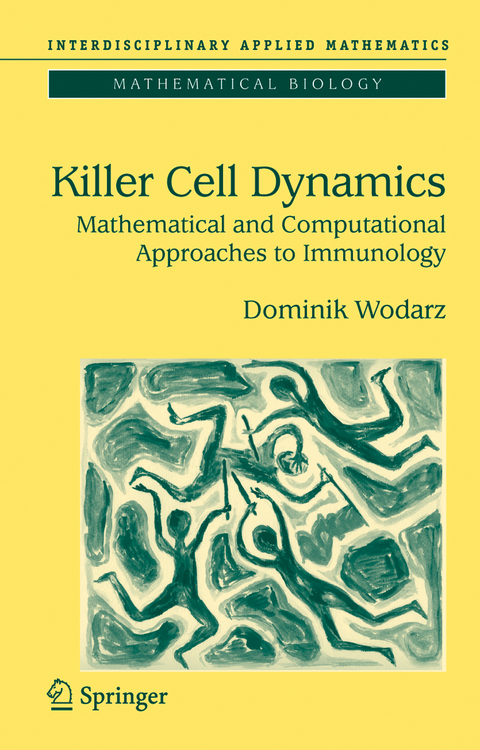
Killer Cell Dynamics
Mathematical and Computational Approaches to Immunology
Seiten
2010
|
Softcover reprint of hardcover 1st ed. 2007
Springer-Verlag New York Inc.
978-1-4419-2165-9 (ISBN)
Springer-Verlag New York Inc.
978-1-4419-2165-9 (ISBN)
Systems biology and computational biology have recently become prominent areas of research in the biomedical community, especially in the area of cell biology. Long before the popularity of systems biology in biomedicine, however, such approaches have been used successfully in a di?erent area of biology: population ecology.
Systems biology and computational biology have recently become prominent areas of research in the biomedical community, especially in the area of cell biology. Given that much information on genes and their protein products has become available, the big question is how the individual components interact and work together, and how this determines the functioning of cells, organs, and organisms. Long before the popularity of systems biology in biomedicine, however, such approaches have been used successfully in a di?erent area of biology: population ecology. Research in the area of population dynamics - vestigated complex interactions between di?erent populations of organisms, such as the dynamics of competition and predation, food webs, community structure, as well as the epidemiology of infectious diseases. In this ?eld, t- oretical biology and mathematical modeling have become an integral part of research. Mathematical models allowed people to obtain interesting and counter-intuitive insights into how complex interactions among di?erent p- ulations can play out. Such mathematical studies not only gave rise to - teresting theoretical ideas, but also provided the basis for the design of new experimental work and de?ned major questions and directions of research. Around 1990, such population dynamic concepts, and the use of mathema- cal/computational approaches, started to be applied to the in vivo dynamics between viruses and the immune system. These interactions have many s- ilarities to ecological, epidemiological, and evolutionary principles. Consider theepidemiologicalspreadofapathogen(suchasthecommoncold)througha population of hosts.
Systems biology and computational biology have recently become prominent areas of research in the biomedical community, especially in the area of cell biology. Given that much information on genes and their protein products has become available, the big question is how the individual components interact and work together, and how this determines the functioning of cells, organs, and organisms. Long before the popularity of systems biology in biomedicine, however, such approaches have been used successfully in a di?erent area of biology: population ecology. Research in the area of population dynamics - vestigated complex interactions between di?erent populations of organisms, such as the dynamics of competition and predation, food webs, community structure, as well as the epidemiology of infectious diseases. In this ?eld, t- oretical biology and mathematical modeling have become an integral part of research. Mathematical models allowed people to obtain interesting and counter-intuitive insights into how complex interactions among di?erent p- ulations can play out. Such mathematical studies not only gave rise to - teresting theoretical ideas, but also provided the basis for the design of new experimental work and de?ned major questions and directions of research. Around 1990, such population dynamic concepts, and the use of mathema- cal/computational approaches, started to be applied to the in vivo dynamics between viruses and the immune system. These interactions have many s- ilarities to ecological, epidemiological, and evolutionary principles. Consider theepidemiologicalspreadofapathogen(suchasthecommoncold)througha population of hosts.
Viruses and Immune Responses: A Dynamical View.- Models of CTL Responses and Correlates of Virus Control.- CTL Memory.- CD4 T Cell Help.- Immunodominance.- Multiple Infections and CTL Dynamics.- Control versus CTL-Induced Pathology.- Lytic versus Nonlytic Activity.- Dynamical Interactions between CTL and Antibody Responses.- Effector Molecules and CTL Homeostasis.- Virus-Induced Subversion of CTL Responses.- Boosting Immunity against Immunosuppressive Infections.- Evolutionary Aspects of Immunity.
| Erscheint lt. Verlag | 1.12.2010 |
|---|---|
| Reihe/Serie | Interdisciplinary Applied Mathematics ; 32 |
| Zusatzinfo | XIII, 220 p. |
| Verlagsort | New York, NY |
| Sprache | englisch |
| Maße | 155 x 235 mm |
| Themenwelt | Informatik ► Weitere Themen ► Bioinformatik |
| Mathematik / Informatik ► Mathematik ► Angewandte Mathematik | |
| Studium ► Querschnittsbereiche ► Infektiologie / Immunologie | |
| Naturwissenschaften ► Biologie ► Evolution | |
| Naturwissenschaften ► Biologie ► Ökologie / Naturschutz | |
| Naturwissenschaften ► Biologie ► Zellbiologie | |
| ISBN-10 | 1-4419-2165-6 / 1441921656 |
| ISBN-13 | 978-1-4419-2165-9 / 9781441921659 |
| Zustand | Neuware |
| Haben Sie eine Frage zum Produkt? |
Mehr entdecken
aus dem Bereich
aus dem Bereich
Operationen- und Prozedurenschlüssel; Internationale Klassifikation …
Buch | Softcover (2023)
Deutscher Ärzteverlag
CHF 34,95
Buch | Softcover (2021)
Springer Spektrum (Verlag)
CHF 69,95


